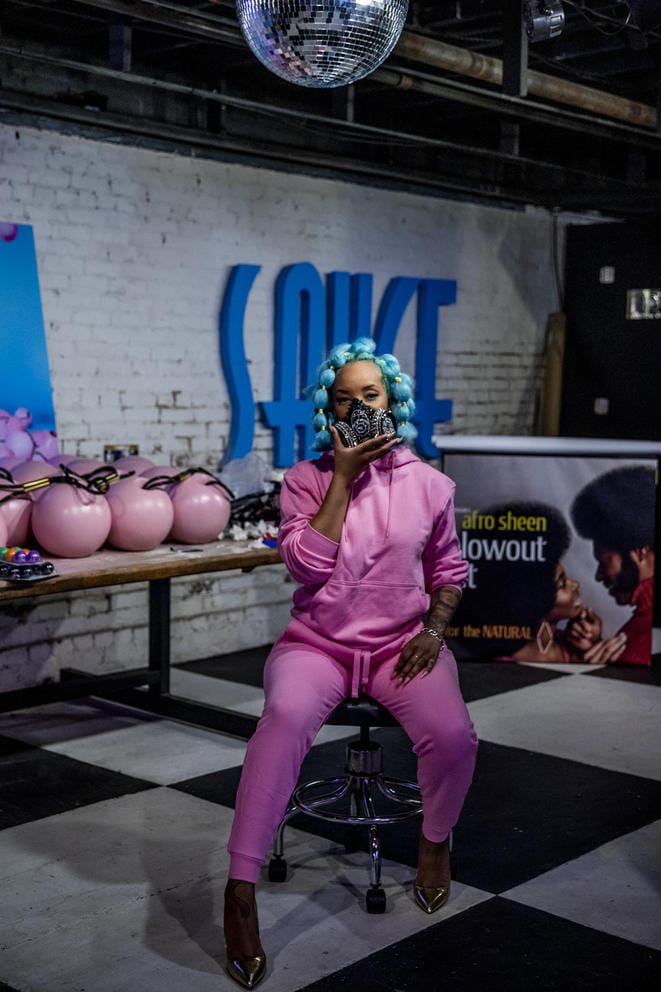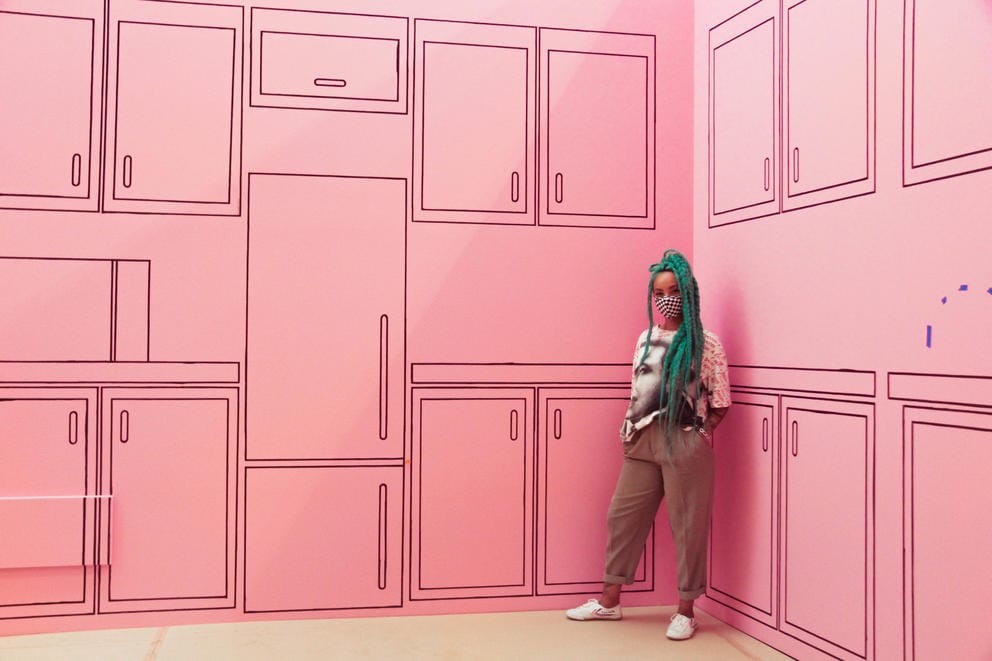Tariqa Waters burst onto the Seattle art scene eight years ago, opening a Pioneer Square gallery with an intriguing name and a tiny footprint — one that belied its mighty impact.
Back then, visitors to Martyr Sauce (named for her daughter’s malapropism of “tartar sauce” and housed entirely in a stairway) were welcomed, on one side, by Waters’s 8-foot tall painting of seventh president and slaveholder Andrew Jackson wearing a pink metal collar.
“Pink is my protest color,” Waters says, sporting a bubblegum-hued dress that contrasts with her turquoise hair. “Everyone loves pink. Or hates it.”
Opposite Jackson in that inaugural installation was a huge yellow sign listing the ingredients of the mysterious Martyr Sauce: “Piss, Distilled Vinegar,” and less than 2% of “Irreverence, High Fructose Cough Syrup, Non Hydrogenated Snake Oil, Street (and/or) Book Smarts, White Privilege, Black Rage, Natural Flavor, Artificial Color.” (Below, the sign noted: “Made in a facility that processes deez nuts.”)
“The business was literally to take the piss,” Waters says, using the British expression meaning “mess with” or “poke fun at.” “If you’re an artist, like in any industry, there are things in place that are going to make you feel like you’re not doing it the right way,” she says. “ ‘These are the steps you're supposed to follow.’ And there are no steps you're supposed to follow.”
Martyr Sauce “doesn’t fit the same narrative as your typical white-box gallery,” Waters says. “Just my presence in Pioneer Square as a Black-run gallery, as a Black woman running these streets, is a whole other disruption.”
Ever since Waters arrived in Seattle’s predominantly white Pioneer Square gallery ecosystem (from Atlanta by way of Sicily and Richmond, Virginia), her trademark approach of shock and awe — with a sense of humor — has sent an electric current through the city’s art scene. Her underground gallery showcases work by local artists alongside her own enormous facsimiles of neon-hued hair extensions, pop-art-style giant replicas of pink toilet paper rolls and Bubblicious gum — and her (prepandemic) First Thursday openings felt like house parties.
This month, she’s taking her Seattle-tested recipe for Martyr Sauce to Bellevue, where she has curated an immersive, candy-colored show opening at Bellevue Arts Museum.
“Tariqa does not conform,” Seattle art world veteran Vivian Phillips, a personal friend of Waters, said via email. “She is not looking to fit into any mold, segment of the society or for any validation…. Seattle is a very clique-oriented city and that is often magnified in the arts community. There's a lot of perceived hierarchy. Tariqa is keenly aware of this, yet she is able to hold fast to [her] own pedigree and function through her own lens. She's so real!!! What you see is what you get, every time!”
The secret: Waters doesn’t take herself too seriously.
“With art conversations and cultural inclusion, it always has this serious tone,” Waters says. “Like, I don't know where the sense of humor went. I think Trump just sucked [out] every ounce of goodness that could possibly exist in this world.”

Tariqa Waters photographed at her gallery, where she has recreated her 2019 Seattle Art Fair booth, which she wallpapered with fake $20 bills on which Harriet Tubman’s face replaced Andrew Jackson’s. (Dorothy Edwards/Crosscut)
Now, with the country in the throes of electing its next president after a summer of Black Lives Matter protests, Waters is harnessing the power of pink — and comical irreverence — again.
She recently painted the street-level railing of Martyr Sauce’s staircase, which leads to the gallery’s current underground iteration, in vibrant strawberry taffy. It looks like frosting on the muted bricks and stone of the historic neighborhood.
“I had to paint it pink just so that people know that there's still a working business down here,” Waters says. “We're still here.”
Even more impressive: Martyr Sauce is expanding. Waters is currently finishing renovations on a street level space next door. She hopes to start showcasing her own work and that of Martyr Sauce artists in the expanded venue by the end of the year.
Opening a storefront gallery during a pandemic that has closed so many art spaces “seems crazy,” Waters admits. But, she says, “I'm going to make sure my presence here is not going to be in vain. I have to make sure we’re moving everything forward. If I'm not actively creating [space] for [artists] and for other kinds of people, I'm just sitting here complaining all day long and just withering away.”
On the contrary, Waters’s artistic career is flourishing. In September the Seattle Art Museum awarded her the Kayla Skinner Special Recognition Award, part of the annual Betty Bowen Award, given to a notable Northwest visual artist (a full-circle connection to her early Seattle years working in the museum’s gift shop and education departments). And she recently marked the five-year anniversary exhibition of Re:Definition, an annual art show she co-founded in 2015 to celebrate artists of color. When the pandemic closed the venue, and thus the show, she created a mural on the historic building’s facade instead.
On Nov. 6, she's opening the major group show she orchestrated at Bellevue Arts Museum, Yellow No. 5. The concept: a Technicolor wonderland that would make Alice jealous, featuring large-scale installations, sculptures, paintings and murals by a dozen local artists, including Aramis O. Hamer, Christopher Paul Jordan, Monyee Chau, Clyde Petersen and SuttonBeresCuller. The show will come with a custom soundtrack featuring local bands like The Black Tones and DoNormaal — so you can splash yourself with Yellow No. 5 at home.
The show will also feature Waters’ own work, including a supersized, rotating lunchbox (embellished with trailblazing Black actress Diahann Carroll) and thermos bottle set in a pink, comic-book kitchen (“everything happens in the kitchen,” Waters notes), a tribute to her working-class single mother. Like Waters, each artist gets to go big, taking over their own corners — some that look like recording booths with black padded walls, some painted aqua and yellow and pink and blue.
“I want the space to look like a children's museum,” Waters says. “I want it to be all immersive where it's a bit disorienting. It's almost like we're having a whole conversation with each other through our work, and people are walking into this conversation.”
Waters has not given up her go-to color (the BAM show will be drenched in pink), but the artificial punch of Yellow No. 5, a synthetic food dye also known as Tartrazine, exudes a particular pull. It’s found mostly in highly processed foods. The bubble gum Waters loves and often incorporates into her art. Mountain Dew. Doritos. Jell-O. Twinkies. Sunny D. Instant pudding. Custard powder. It’s the sweet stuff that gives us a sugar rush. The food that brings instant comfort.
But it’s not as straightforward as colors and candy. Not all of the art in the show is escapist or humorous. Yellow No. 5 (both the additive and the show) is also a manifestation of consumerism in overdrive. As with much of pop art, Waters blurs the boundaries between critique and celebration.
She has honed her talent for combining childlike wonder with commentary at Martyr Sauce (“Hours: Whenever the Fuck we’re here”). Descending into the space is like opening a latch into Waters’ brain. It’s dark, like her humor, but full of shiny things vying for your attention: A checkerboard floor. Disco-ball mirror mosaic tiles spelling out “MARGINALIZED.” Pink neon letters reading “Bad Bitch.” Jumbo dice as coffee tables.
“I always channel either David Byrne or Pee-wee's Playhouse,” says Waters, who has two children, an 18-year old son and 16-year old daughter. “I want to make sure that when kids come in, they feel like, ‘Oh, I belong in here too.’ ”
Walking along on the checkerboard floor full of Waters’ huge replicas of consumer objects feels like starring in a cynical pop-art version of Honey, I Shrunk the Kids: An 8-foot-tall four-pack of Quilted Northern toilet paper (pink, of course) towers above my head, alongside supersized packs of Bubblicious, and heaps of beach-ball-sized pink-ball ponytail holders. Much like Waters, it’s all larger than life.
“People really love impact,” she says. “I think that's the reason why we're in trouble with Trump, because people just want to feel like, ‘Oh, this is so crazy.’ ”
But for all its bright colors and pop culture nostalgia, the work often masks gravity, and even trauma.
“The things that I pull from that bring people the most joy is also the thing that came from a lot of pain,” she says. “Kind of like a sensory kind of jolt where I didn't have to think about the thing that was fucking with me. ‘It was OK: Let me just open up this pack of bubble gum’.”
“My whole ‘laugh and keep on’ comes from my childhood,” says Waters, who turns 40 this year and dreams of dipping her toes into stand-up comedy.

Artist Tariqa Waters has honed her talent for combining childlike wonder with commentary at Martyr Sauce, her irreverent underground gallery (Dorothy Edwards/Crosscut)
She is allergic to the art world’s self-important crutches — the artists and curators taking themselves too seriously, lathering artworks with artspeak gobbledygook. The gatekeeping. The galleries where your presence feels like a stain on the pristine white box.
In other words, as Waters puts it: “People really love the smell of their own shit.”
At last year’s Seattle Art Fair, Waters called it as she saw it: the Vulcan-sponsored, CenturyLink-sized event (which featured very few Black-owned galleries) was about cold, hard cash. As one of the fair’s cultural partners, she got a small booth, which she wallpapered with $20 bills on which Harriet Tubman’s face replaced Andrew Jackson’s. Waters created a coffee table shaped like giant bills, too, and dressed in leggings and a T-shirt featuring the same pattern.
“It just made Tacoma Art Museum and Seattle Art Museum and Bellevue Arts Museum and all the other kind of ‘boring’ museums … look like a bunch of old squares, basically,” recalls BAM Executive Director Benedict Heywood. “She was just hardcore doing what she does — rather than pandering. Which is what institutions tend to do.”
Two days before the show opens, Waters is doing her ‘hardcore’ art thing again on the third floor of BAM.
While the colors may be hyper, Waters’ mood is muted. It’s the day after the election, and she’s worried and tired. Navigating a predominantly white, male institution as a Black woman — especially at a time when a president who told far-right extremists to "stand by" is a contender for reelection — it’s a lot to carry, she says, as we take the elevator down from the third floor.
She worries the show, which has been in the works for over a year, might come across as tone-deaf in this current moment. At the same time, “It’s important to have this up during a time like this,” she says. We walk outside into the blustery, gray evening. “We’re giving you that hug that we all desperately need.”

Tariqa Waters poses inside her in-progress installation at the Bellevue Arts Museum, where she’s curated a Technicolor show featuring a dozen local artists. She’ll install a supersized, rotating lunchbox and thermos bottle inside the pink kitchen. (Margo Vansynghel/Crosscut)


